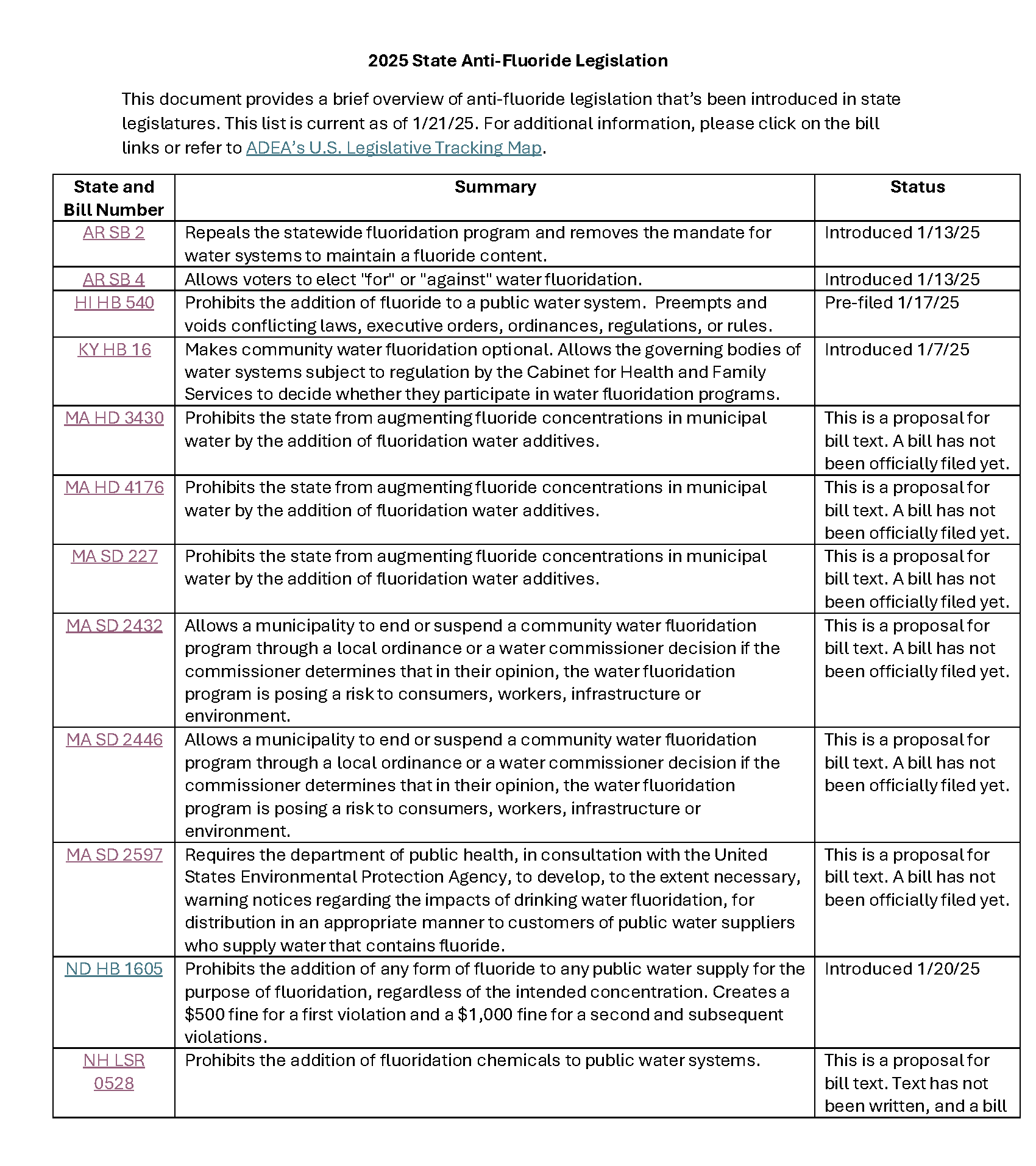
Community Water Fluoridation
- Policy
- Advocacy
-
Diversity
- Pathways to Smiles
- HURE Report
- Diversity Checklist
-
Faculty Diversity Toolkit
- Chapter 1: Introduction
- Chapter 2: Barriers and Challenges to Recruiting and Retaining Diverse Faculty
- Chapter 3: Best Practice Highlights—Recruiting and Hiring Diverse Faculty
- Chapter 4: Best Practice Highlights—Retaining Diverse Faculty
- Chapter 5: Conclusion
- Appendix B: Diversity and Inclusion Terminology
- Strategic Framework 1-1
- Policy on Diversity
- Climate Study
- Student Leaders for Social Change
American Dental Education Association
Community Water Fluoridation
National efforts of community water fluoridation prevent oral diseases, deliver health care savings and reduce oral health disparities. ADEA strongly supports optimal fluoridation of community water. Community water fluoridation is safe, practical and the most cost-effective measure for the prevention of dental caries.
The oral health education community is committed to ensuring graduates are competent in:
- Raising awareness of water fluoridation as an imperative public health issue;
- Discussing fluorides and water fluoridation with school-based clinic patients; and
- Evidence-based preventive dentistry, including the promotion of water fluoridation.
In the summer of 2015, the U.S. Surgeon General stated that community water fluoridation is one of the 10 greatest public health achievements of the 21st century.1
“As Surgeon General, I encourage all Americans to make choices that enable them to prevent illness and promote well-being. Community water fluoridation is one of the most practical, cost-effective, equitable, and safe measures communities can take to prevent tooth decay and improve oral health.”2
Providing optimally fluoridated water to U.S. communities for one year saves $6.5 billion in dental treatment costs and offers an average return on investment of $20 for every $1 spent.
On average, communities with water fluoridation experience 25% fewer cavities, saving $32 per person annually by avoiding dental treatment costs and leading to fewer missed work and school days.3
Oral diseases cause pain and disability for millions of people in the United States, and some are linked to other diseases—like diabetes, heart disease and stroke. Regular visits to the dentist can help prevent oral diseases and related problems, but most people have not been to the dentist in the last year. Strategies to make it easier for people to get dental care are critical for better oral health and overall health outcomes.
Every decade since 1980, the Department of Health and Human Services Healthy People initiative identifies science-based, national objectives with the goal of improving the health of all Americans over the course of the following 10 years. The goal of the Healthy People 2030 oral health objectives is to improve oral health by increasing access to oral health care, including preventive services.
1Surgeon General Perspectives, Public Health Rep. 2015 Jul-Aug;130(4):296–298.
2Ibid.
3www.cdc.gov/oral-health/php/infographics/roi-fluoridated-water.html, Public Health Rep. 2015 Jul-Aug;130(4):296–298.
Resources
Water Fluoridation Peer-reviewed Literature
- CDC MMWR. Recommendations for Using Fluoride to Prevent and Control Dental Caries in the United States.
- Hayes C, Douglas CW, Kim FM, Burgard SL, et al. A case-control study of topical and supplemental fluoride use and osteosarcoma risk. JADA 2021; 152(5):344-53.
doi: 10.1016/j.adaj.2021.01.010
- Sanders AE, Grider WB, Maas WR, Curiel JA, Slade GD. Association between water fluoridation and income-related dental caries of us children and adolescents. JAMA Peds 2019;173(3):288-90. doi: 10.1001/jamapediatrics.2018.5086
- Heng C. Tooth decay is the most prevalent disease. Fed Pract 2016; 33(10):31-3.
- O’Connell J, Rockell J, Ouellet J, Tomar SL, Maas W. Costs and savings associated with community water fluoridation in the United States. Health Affairs 2016; 35(12):2224-32. doi: 10.1377/hlthaff.2016.0881
- Dye BA, Thornton-Evan G, Xianfen L, Iafolla TJ. Dental caries and tooth loss in adults in the United States, 2011–2012. NCHS Data Brief. Accessed: Jan. 17, 2025.
- Melbye ML, Armfield JM. The dentist’s role in promoting community water fluoridation: a call to action for dentists and educators. JADA 2013; 144(1):65-73. doi 10.14219/jada.archive.2013.0016
- Neidell M, Herzog K, Glied S. The association between community water fluoridation and adult tooth loss. AJPHA 2010; 100(10):1980-5. doi: 10.2105/AJPH.2009.189555
- Griffin SO, Regnier E, Griffin PM, Huntley VN. Effectiveness of fluoride in preventing caries in adults. J Dent Res 2007; 86(5):410–4. doi: 10.1177/154405910708600504
Posted on July 16, 2025
ADEA Public Comments to the FDA on Ingestible Fluoride Products (PDF)
View ADEA's statement in support of maintaining optimal levels of fluoride in community water.

